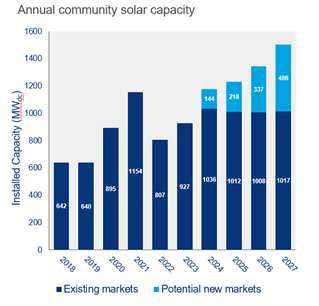Get in touch
-
Mark Thomtonmark.thomton@woodmac.com
+1 630 881 6885 -
Hla Myat Monhla.myatmon@woodmac.com
+65 8533 8860 -
Chris Bobachris.boba@woodmac.com
+44 7408 841129 -
Angélica Juárezangelica.juarez@woodmac.com
+5256 4171 1980 -
BIG PartnershipWoodMac@BigPartnership.co.uk
UK-based PR agency
US community solar sector market forecast to grow 7 GWdc by 2027
Pending legislation for community solar programs in five states could add another 1.2 GWdc
3 minute read
The US community solar market will continue to grow over the next five years, with at least 7 gigawatts direct current (GWdc) of community solar expected to come online in existing markets between 2022-2027.
New program guidance for community solar programs in existing markets and potential new community solar markets will bring significant growth for the US community solar market, according to new research, released today by Wood Mackenzie, a Verisk business (Nasdaq: VRSK) in collaboration with the Coalition for Community Solar Access (CCSA).
Wood Mackenzie has increased its 2022-2026 forecast by 477 megawatts direct current (MWdc), an 11% uptick compared to previous forecasts and extended its outlook to 2027. This increase is due to the addition of new community solar markets, such as New Mexico and Delaware, and adjustments to existing state forecasts as state-level programs are expanded and rules are updated.

Illinois and New York account for the greatest state-level changes to the forecast. New York is projected to continue to be the leading community solar market, with 1.3 GWdc coming online between 2022-2027.
“The community solar industry is a growing solar segment within the US, with several proposed new programs pending in state legislatures. Since the start of Q2 2022, 4.4 GWdc has been installed nationally and we expect to see more growth over the next five years as legacy markets expand their community solar programs and new states adopt community solar programs,” said Rachel Goldstein, US Solar Research Analyst for Wood Mackenzie.
“There continue to be significant tailwinds for the community solar industry as legislators in existing and new states look to community solar as a way to achieve energy policy goals,” said Jeff Cramer, CEO of CCSA. “The numbers released by Wood Mackenzie represent a conservative forecast of what’s in the pipeline for the next few years. We call on all federal and state policymakers to help remove the barriers and incentivize deployment of community solar to cut energy costs and give more people access to these programs.”
In this report, Wood Mackenzie and CCSA collected data on customer acquisition costs for the US community solar market and found that costs to acquire large customers are lower, but more variable, on a per watt basis than acquisition costs for residential customers.
“Customer acquisition data shows that cost per customer is inversely correlated with cost per kilowatt subscribed. Anchor tenants like Municipal or Large Commercial customers are costly to acquire but subscribe to a large share of projects, so costs per kilowatt are lower,” Goldstein said.
Data from surveys for low- and moderate-income (LMI) customer acquisition costs is limited but shows that these costs are slightly higher than for non-LMI customers. Developers report that directly-billed LMI customers can be significantly harder and more expensive to subscribe than residential customers.
Report findings also highlighted that community solar-plus-storage can provide grid flexibility, but regulatory models do not currently recognize how these projects can manage load.
“As community solar becomes an increasing share of non-residential projects, developers are contending with high grid upgrade costs to manage this new load on the distribution end of the grid. Community solar-plus-storage could help manage this load and provide grid flexibility, but so far, its scope is limited to a few states, and current rules do not necessarily value storage for its grid resilience capabilities,” said Goldstein.
Massachusetts now requires SMART-qualifying facilities larger than 500 kilowatts (kW) to be co-located with storage, while New York’s Value of Distributed Energy Resources (VDER) provides financial incentives for co-locating community solar with storage.
New regulatory proposals in California could help the state contend with new net metering rules while providing financial advantages for community solar-plus-storage projects.
At present, community solar is taking root in a third of states. The Biden Administration wants community solar to reach 5 million households by 2025 and create $1 billion in energy bill savings.





